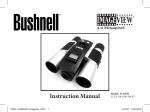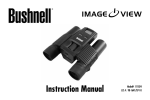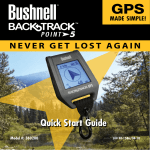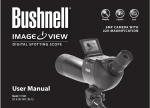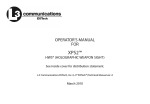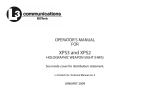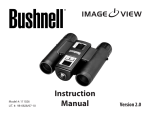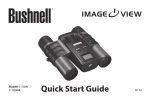Download Bushnell 118330 Binoculars User Manual
Transcript
3.0 Megapixel
Instruction Manual
Model: 118331/118330
Lit.#: 98-1276/09-08
Congratulations on your purchase of the Bushnell ImageView® binocular! The
Bushnell ImageView binocular takes the technology of digital photography
and combines it with a high-quality compact binocular. This allows you
to observe sporting events, wildlife, scenic vistas or anything you would
normally use a binocular for, and also save what you see by snapping a photo
with the built-in digital camera. You can then download these images to your
computer and e-mail them to your friends and family, print a favorite photo
for framing, or add the photos taken with your ImageView binocular to any
document. Before using the product, please read the instructions contained
in this manual and take time to familiarize yourself with the different parts
and features of the product.
QUICK GUIDE: BUSHNELL IMAGEVIEW 118331
INSTALL BATTERIES
Insert 2 AAA batteries (alkaline, lithium, or rechargeable NiMh) as indicated inside the
battery compartment on the bottom of the ImageView.
ADJUST THE BINOCULAR FOR COMFORTABLE VIEWING
Adjust the center focus knob while viewing a distant object through the binocular, until
it appears sharp. Move the left and right sides of the binocular closer together or farther
apart until you see a single circular image. Rotate the right eyepiece (diopter adjustment)
to change the setting if the image does not appear as sharp to your right eye as it does to
your left eye.
TURN ON THE CAMERA
Press the MODE button briefly, then release it. You will see a battery indicator and 3
digits indicating the number of photos taken (currently stored in the internal memory).
As you take new photos, this counter will advance. Press and hold MODE to turn off the
camera. You should download all photos before changing batteries or storing the camera
unused for a long period of time (more than a few weeks) as a precaution.
QUICK GUIDE: BUSHNELL IMAGEVIEW 118331
CHECK CAMERA SETTINGS
Make sure the camera is set for high resolution and quality (refer to pg.8, “Setup Menu”)
if you want the best results, especially if you will be printing the photos. See “Changing
Operational Modes” for full instructions covering features such as continuous shot, shooting
a video clip, and how to delete a photo you have just taken.
TAKE A PHOTO (Tips For Better Quality Photos)
Holding the ImageView as steadily as possible with both hands wrapped around the binocular,
lightly press down the SNAP button using the flat end of a finger. Leaning against a wall, tree,
etc. to brace yourself can also help insure the camera does not move as you take the photo.
Or, use the included tripod and remote shutter cable (see pg. 9) when possible. Make sure you
are at least 30 feet or more away from your photo subject. Unlike the binocular optics (which
will focus down to about 15 ft.), the camera focus is preset and is designed only for distant
subjects- your photos may look out of focus if you were too close.
USING THE IMAGEVIEW WITH YOUR COMPUTER
Connect the supplied USB cable between the ImageView and your computer, using a USB
port on the computer itself (avoid USB “hubs”). Please read “Downloading Photos to Your
Computer” for detailed instructions on transferring your photos to a PC or Mac computer.
BASIC OPERATION
TURNING THE CAMERA ON AND OFF
Insert 2 AAA alkaline batteries as indicated on the inside of the
battery compartment, located on the bottom of the camera unit.
Turn the camera on by pressing and holding the MODE button
until the display comes on and the camera beeps. To turn the unit
off, press and hold the MODE button until the display goes out.
The camera will turn itself off automatically to save batteries if
none of the buttons have been pressed for two minutes.
TAKING A PICTURE
With the camera turned on, press the SNAP button to take a new
photo. For best results, hold the ImageView steady using both
hands, and lightly press down the SNAP button using the flat
end of your finger rather than “punching” it with a fingertip. Or,
whenever possible, mount the camera on the tripod and use the
remote shutter cable (both included) to avoid camera shake*. Be
sure you are at least 35 feet away from your subject as the camera
focus is preset for optimum results with distant objects (sports,
wildlife, etc.).
MODE
(Power)
SNAP
(Shutter
Release)
* Please refer to the tripod and remote cable photos on pg. 9
5
LCD display
1. High Quality Mode (less file compression)
2. Deletes all the pictures in the memory.
3. Low Quality Mode (more file compression)
4. Deletes the last picture taken.
5. Select the timer to take a delayed picture. This gives you
approximately a 10-second delay.
6. SD mark appears when an SD card is inserted.
7. This mode allows you to take short movie clips, saved as “.avi” files.
8. USB mark appears when USB cord is connected between the camera and the PC.
9. Battery mark keeps track of the battery life left.
10.
Indicates Resolution setting (4 stars=highest resolution, 1 star=lowest resolution)
11.
This section of the display is used for three different types of indication:
a. Photo Number-in normal operation, the number of photos stored (in internal or card memory) is seen here.
b. Memory Full-when the memory is full, the display indicates “FUL” here. Download your photos,
then “Delete All” to take more. Or change to a new, blank SD card.
c. Setup Menu-displays the current setting for each of the 4 options in the Setup Menu
BASIC OPERATION
1. The camera is powered by two AAA alkaline, lithium or rechargeable NiMh batteries.
2. Insert the batteries into the battery compartment. If greater storage for photos/videos is desired (the internal
memory capacity is approx 6MB), insert an SD card ("upside down" with metal contacts facing up) in the card
slot. You may use SD cards up to 1 GB. To remove an SD card, simply pull it straight out of the card slot.
3. Press and hold the MODE button until the camera turns on.
4. Press SNAP to take a picture, or press the MODE button quickly to change mode settings as described above. The
camera focus is preset and designed to deliver sharp results beginning at approximately 35 feet from the camera.
6
CHANGING OPERATIONAL MODES
Pressing the MODE button briefly will cycle through several special camera modes and settings. A
corresponding icon or symbol (indicated in parentheses below) will be displayed on the LCD for each mode
or setting as you cycle through them by tapping the MODE button. When the icon for a mode or setting is
displayed, pressing SNAP will select that mode or change that setting. If no button is pressed for more than
5 seconds, the camera will return to normal operation. The modes/settings are shown as you cycle through
them in the following order:
• Timer ( ) : selects the self-timer, which will take a photo after a 10 second delay when you press the
SNAP button. This can be used to avoid moving or shaking the camera by pressing the SNAP button
when the camera is placed on a table or other level surface. A series of “beeps” with increasing frequency
will be heard. After using the self timer, the camera automatically returns to normal operation (timer is
canceled).
• Video Mode: ( ) : This mode sets the camera to take short video clips (.avi files) rather than still
photos. With the movie camera icon displayed, press SNAP to begin shooting the video. The counter will
show elapsed seconds . Press SNAP again to stop shooting the video. The counter will advance by one
number, as a new file (video) has been stored in the internal memory. After shooting the video clip, the
camera reverts back to normal still photo operation (assuming unused memory remains). Repeat the
steps to set AVI mode again if you wish to shoot more video clips.
• Continuous Shot ( CS ) : Takes rapid series of 3 consecutive photos, approx. 1 second apart, when you
press and hold the SNAP button. You will hear a short beep when each photo is taken. As with the timer,
the camera will return to normal operation after the shots are taken, cancelling the CS mode.
• Delete All ( ) : With this mode is selected, press SNAP once, and the number of total photos in
memory will blink in the display. Press the SNAP button a second time to erase the entire memory
contents. If SNAP is not pressed a second time while the photo counter is blinking, the camera will
7
CHANGING OPERATIONAL MODES continued
return to normal operation in a few seconds (all your photos will not be deleted). When the process is
complete, the photo number display will reset to zero. If no button is pressed for 5 seconds, the camera
returns to stand-by. “Delete All” is a quick way to clear the memory following a download of your
photos to a computer, so that the camera is ready to hold as many new photos as possible.
• Delete One ( ) : Pressing SNAP when the “Delete One” icon is displayed will delete (erase) only the
last photo you took from the camera’s memory.
• SETUP Menu (SET): Pressing SNAP when “SET” is displayed will enter the Setup Menu display, which
has four different settings, each with two options available. Use the MODE button to cycle through the
four settings. Pressing the SNAP button will switch (“toggle”) between the two options per setting. The
four settings (plus “ESC” to exit the setup menu) are displayed in the following order:
File Size/Resolution (1-4 Stars): High resolution (3 or 4 stars) settings are recommended for best
results, but low resolution can be used if you need to shoot a greater quantity of photos before
downloading, and quality is not a high priority.
Quality (Hq or Lq) : Select “Hq” for High Quality photos (recommended setting, least amount of
file compression). Select “Lq” (Low Quality) to store more photos in memory but with a slight loss
in quality due to greater file compression.
USB Mode (STO or PCC): Always select “STO” , allowing you to download and view the photos
in the camera’s memory when it is connected to your PC with a USB cable (included). “PCC” is a
live PC camera option that is was not implemented in this camera model (software is not supplied
or available for this application), as the camera has a fixed focus preset for distances of 30 feet or
greater.
8
SETUP MENU continued
Power Frequency (60 or 50 Hz): This sets the correct electrical line frequency to avoid any visible
“flickering” in the images, especially when shooting video clips where fluorescent lighting is present.
The “60” setting should be used for operation in the United States. If you are using the camera in a
country with 50 Hz (cycle) AC power frequency, press SNAP to select “50” instead.
• Escape (ESC): Select ESC and press SNAP to exit the Setting menu options, and return to normal
mode.
OTHER DISPLAY ICONS
• Battery Indicator (
) : Shows the amount of battery life left. When half of the icon is filled in, you
should plan to replace the batteries soon. Be sure to bring an extra set of batteries on a long trip or for
important events.
CAUTION: Make sure you download all photos (see directions in next section of manual) from the camera
before removing the batteries for longer than the time it takes to change them. The camera memory is volatile (power
dependant), and your photos may be lost if the batteries are removed for more than a minute or two (a temporary charge
will remain long enough to allow changing batteries), or if the batteries are left in but allowed to become completely
dead.
Attaching the Tripod (Included)
Inserting the Remote Shutter Cable (Included)
9
Photo Storage Capacity Reference (avg. capacity for settings, +/- 5 photos)
Image Size
# of Star
Icons
2034x1728
4
Megapixels
(approx)
Quality 1
Setting
Internal
Memory 2
256 MB
SD Card
4.0 (Interpolated)
High
7 photos
299 photos
Standard
11
469
High*
10
427
Standard
14
597
High
15
640
Standard
22
939
High
116
4,949
Standard
168
7,168
4
2048x1536
3*
3.1*
3
1600x1200
2
1.9
2
640x480
1
1
0.3 (“VGA”)
* Default settings: 3.1 megapixel resolution (3 stars), High quality (Hq)
additional Specifications
Video Clip Resolution: 320x240 pixels per frame @10 fps rate, avi file format
Maximum Video Recording Time: determined by available internal or card memory.
Approx. 5 minutes using full capacity of available internal RAM memory.
Maximum SD Card Capacity: 1 GB (gigabyte), standard speed recommended
Imaging Sensor: 3.14 MP CMOS
Internal RAM: 8MB, approx 6MB maximum available for photo/video file storage.
Capacitor maintains memory contents for 1-2 minutes while changing batteries. Use
of SD card recommended to avoid potential loss of files if batteries become depleted.
10
Notes
1 Determines amount of file
compression:
Hq: High Quality (minimum
compression)
Sq: Standard Quality (medium
compression)
2 Internal RAM available for
photo files: approx. 6 MB
“Image Size” refers to the pixel
dimensions, or resolution, of the
digital file.
Actual storage capacity will vary
based on content of each photo
file. You may be able to take a few
photos more or less than the listed
average capacity.
Use higher resolution and quality
settings for photos you may want
to enlarge or crop later. If required,
they can always be reduced to a
smaller file size using your photo
software. Use lower resolution
and/or standard quality settings
if you will only email, insert into
documents, or make small prints,
and do not want to resize the file
later.
DOWNLOADING THE PHOTOS/VIDEOS TO YOUR COMPUTER-Step by Step:
1. Connect the supplied cable to the ImageView’s USB port, then directly to a main USB port on your computer-do
not use front panel/keyboard USB ports or unpowered “hubs”. The camera will be recognized as a USB mass storage
device (with USB Mode set to “STO” and not “PCC”-see pg.8), which means no special drivers are required for all
recent Windows PCs (Win98 and earlier Windows operating systems are not supported). Mac OS 9 and OSX are
also compatible. Once the LCD display indicates “STO”, the camera files can be easily viewed, edited, or copied
to your hard drive, just as if they were stored on an external hard drive
2. (This step is not required with Windows XP or Vista, simply use the options in the pop-up window to view, copy or
edit your photos). If you have a computer OS as listed above that is USB mass storage compliant, a new disc icon
will appear in Windows Explorer (under “My Computer”) showing the Imageview as a new “Removable Disc” after
plugging in the USB cable from the Imageview. Mac users will see the new disc device appear on their desktop.
Clicking on the new disc icon will show the contents, a folder named “DCIM.” The image folder inside this contains
your photos, stored as JPEGs (.jpg file format). They may then be opened, edited, renamed and saved using any
photo or graphics software that accepts .jpg files. Open My Computer or Windows Explorer. The camera will be
seen as a new “Removable Disk” with an unused drive letter assigned to it. Double click this new “Disk” icon,
open the “DCIM” folder inside, then the folder(s) inside that (“100MEDIA” ,etc). Your photos/videos are the
files inside-they have the prefix “IMG__” followed by a number, same as seen earlier on the camera’s display
when you review photos. Single clicking any file should show a small preview image.
3. Click “Edit>Select All” (or click on one photo, contol+click to select multiple photos), then “Edit>Copy to
Folder” (in Windows menus). Select an existing folder on your hard drive, such as “My Pictures”, or create a new
folder (“Hawaii Vacation”, etc), then click “OK” to transfer copies of the photo files you want.
4. After you have copied or opened and saved the photo files to your computers hard drive, you may disconnect
the ImageView.
11
DOWNLOADING THE PHOTOS/VIDEOS TO YOUR COMPUTER-Step by Step:
(NEVER disconnect the camera while files are still being transferred to your computer.) Before disconnecting,
you may need to “eject” or stop the removable disc representing the camera to avoid an error message on
computers running Windows 2000 or Mac OS. After the photos are transferred to your hard drive, you can
disconnect the camera. Windows 2000 may produce a screen warning that you have disconnected a USB device
without stopping or ejecting the “disk” first (your photo files will not be harmed). If you’re using a Mac (OS9 or
OSX), you should “eject” the “disk” that represents the camera on the desktop before disconnecting.
5. You’re now ready to open the photo files in any photo editing software. Just use File>Open and go to the
folder where you stored the photos earlier. It is also possible to open and work with your photos directly from the
ImageView while it is still connected.If you choose to work this way, from a connected camera, be sure that you
save the photo (when you are done editing) to your hard drive, and not the camera’s memory or card.
6. If you are new to photo editing on a computer, consult your software’s Help menu for tips on using its features.
Along with adjusting the brightness, contrast, sharpness and color of your photos, you can resize the photo to
fit the paper if you are printing, or save a smaller, low or medium resolution version for email or inserting into
documents. When you are ready to save your edited file, you may want to use “Save As” and give it a more
descriptive name than “IMG___”. Doing this also preserves the original file as a backup to reopen and re-edit
later. Make sure you have successfully transferred all the photos you wanted to save before using “Delete All” on
your camera to make room for new images.
WARNING: Make sure you download any picture from your camera before you remove the
batteries from the camera.
12
Binocular Instructions
EYE ADJUSTMENTS (Fig. 1)
How to Adjust For Distance Between Your Eyes
The distance between the eyes, called “interpupillary distance,” varies from person to person. To
achieve perfect alignment of lens to eye, follow these simple steps.
1. Hold your binocular in the normal viewing position.
2. Grasp each barrel firmly. Move the barrels closer together or further apart until you see a
single circular field. Always re-set your binocular to this position before using.
Fig. 1
Interpupillary Distance
How to Adjust For Individual Eye Strength
As individual eyesight varies from one person to another, Bushnell binoculars have a diopter setting feature which allows you to finetune the binocular to your vision. Follow the focusing instructions below for your binocular.
FOCUSING
Fig. 2
1. Adjust interpupillary distance. (Fig. 1)
2. Set the “diopter setting” (Fig. 2) to zero and view a distant object.
3. Keep both eyes open at all times.
4. Using a lens cover or your hand, cover the objective (front) lens of the same side of the binocular
diopter setting
that has the “diopter setting”. This is usually the right side.
5. Using the center focus wheel, focus on a distant object with fine detail (e.g., brick wall, tree branches, etc.) until it appears
as sharp as possible.
6. Uncover the objective lens on the diopter side, cover the other objective lens, then view the same object.
7. Using the “diopter setting” adjustment ring, focus the same object being viewed. Caution should be used as over turning or
forcing the diopter eyepiece can cause damage or cause the eyepiece to break away from the chassis.
8. Your binocular should be adjusted for your eyes. Focus at any far or near distances can now be attained simply by turning the
center focus wheel. Make a note of the diopter setting for your eyes for future reference.
13
Binocular Instructions
EYECUPS (Fig. 3)
Your Bushnell binocular is fitted with rubber roll-down eyecups designed for your comfort and to
exclude extraneous light. If you wear sun/eyeglasses, roll down the eyecups. This will bring your
Fig. 3
eyes closer to the binocular lens thus providing improved field of view.
roll-down eyecups
INSTRUCTIONS FOR CARE OF BINOCULARS
Your Bushnell binocular will provide years of trouble-free service if it receives the normal care you would give any fine optical
instrument. Non-waterproof models should not be exposed to excessive moisture.
1. If your binocular has roll-down, flexible eyecups, store it with the eyecups up. This avoids excessive stress and wear on the
eyecups in the down position.
2. Avoid banging and dropping.
3. Store in a cool, dry place.
4. CAUTION: Looking directly at the sun with your binocular may be very harmful to your eyes.
5. Never expose your ImageView binocular to any type of excessive of liquid or fluid, as the binocular is not water/fogproof.
6. Take the batteries out of your ImageView if you are not going to use it for a long period of time. (Make sure you download
any pictures from your camera before you remove the batteries from the camera.)
CLEANING
1. Blow away any dust or debris on the lens (or use a soft lens brush).
2. To remove dirt or finger prints, clean with a soft cotton cloth rubbing in a circular motion. Use of a coarse cloth or
unnecessary rubbing may scratch the lens surface and eventually cause permanent damage. A “microfiber” cleaning cloth
(available at most photo dealers) is ideal for the routine cleaning of your optics.
3. For a more thorough cleaning, photographic lens tissue and photographic-type lens cleaning fluid or isopropyl alcohol may
be used. Always apply the fluid to the cleaning cloth – never directly on the lens.
14
TWO-Year LIMITED WARRANTY
Your Bushnell® product is warranted to be free of defects in materials and workmanship for two years after
the date of purchase. In the event of a defect under this warranty, we will, at our option, repair or replace
the product, provided that you return the product postage prepaid. This warranty does not cover damages
caused by misuse, improper handling, installation, or maintenance provided by someone other than a Bushnell
Authorized Service Department.
Any return made under this warranty must be accompanied by the items listed below:
1) A check/money order in the amount of $10.00 to cover the cost of postage and handling
2) Name and address for product return
3) An explanation of the defect
4) Proof of Date Purchased
5) Product should be well packed in a sturdy outside shipping carton, to prevent
damage in transit, with return postage prepaid to the address listed below:
IN U.S.A. Send To: Bushnell Outdoor Products
Attn.: Repairs
8500 Marshall Drive
Lenexa, Kansas 66214
IN CANADA Send To:
Bushnell Outdoor Products
Attn.: Repairs
25A East Pearce Street, Unit 1
Richmond Hill, Ontario L4B 2M9
For products purchased outside the United States or Canada please contact your local dealer for applicable
warranty information. In Europe you may also contact Bushnell at:
Bushnell Germany GmbH
European Service Center
Mathias-Brüggen-Str. 80
GERMANY
D- 50827 Köln
Tel: +49 221 995568-0
Fax: +49 221 995568-20
This warranty gives you specific legal rights.
You may have other rights which vary from country to country.
©2008 Bushnell Outdoor Products
FCC Note:
This equipment has been tested and found to comply
with the limits for a Class B digital device, pursuant
to Part 15 of the FCC Rules. These limits are designed
to provide reasonable protection against harmful
interference in a residential installation. This equipment
generates, uses and can radiate radio frequency energy
and, if not installed and used in accordance with the
instructions, may cause harmful interference to radio
communications. However, there is no guarantee that
interference will not occur in a particular installation. If
this equipment does cause harmful interference to radio
or television reception, which can be determined by
turning the equipment off and on, the user is encouraged
to try to correct the interference by one or more of the
following measures:
·Reorient or relocate the receiving antenna.
·Increase the separation between the equipment and receiver.
·Connect the equipment into an outlet on a circuit
different from that to which the receiver is connected.
·Consult the dealer or an experienced radio/TV
technician for help.
The shielded interface cable must be used with the
equipment in order to comply with the limits for a digital
device pursuant to Subpart B of Part 15 of FCC Rules.
Specifications and designs are subject to change without
any notice or obligation on the part of the manufacturer.
INNOVATION THAT THRIVES OUTSIDE
For further questions or additional information please contact:
Bushnell Outdoor Products
9200 Cody, Overland Park, Kansas 66214
(800) 423-3537 • www.bushnell.com
©2008 Bushnell Outdoor Products
















